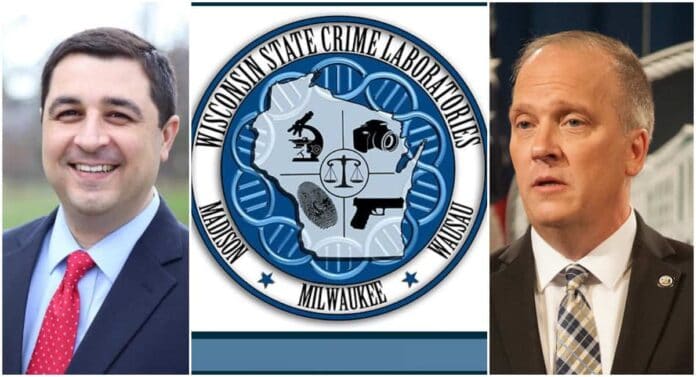AG Josh Kaul’s crime lab is worse on many key measurements than his predecessor, yet the media aren’t holding him accountable. That’s a double standard.
Wisconsin Attorney General Josh Kaul has failed on public safety, with crime lab delays worse in key areas – like guns and DNA – than those under former Republican AG Brad Schimel.
Even though Schimel’s crime lab was more productive and effective, he was hammered relentlessly by Kaul and the news media. Yet Kaul’s worse record isn’t getting much scrutiny even as a Republican AG primary gears up.
At a time of soaring crime rates, Kaul’s crime lab is taking in far fewer cases (a trend that started BEFORE COVID-19), but it’s also taking longer to get police and prosecutors key evidence they need to get criminals off the streets, a review of his own data shows. Kaul has offered excuse after excuse for this fact, but the crime lab’s role in public safety has unquestionably diminished under his leadership:

Kaul has gutted the Department of Justice’s public safety mission, DOJ data shows. Under his leadership, the Division of Forensic Sciences, which houses the state crime labs, handled almost 30% fewer cases than during Schimel’s last year, a trend that took root during his first year in office, 2019.
The data comes from Kaul’s 2020 report, which was released in April to a flurry of generally positive news stories, many of which focused on the pandemic or comparing Kaul’s 2020 numbers to his numbers for 2019, his first year in office. He showed incremental progress in some areas when compared to himself.
What we did but the media largely failed to do was take a longer look back and compare Kaul’s first two years in office to the crime lab under Schimel. He doesn’t fare well.
The AG has not yet released numbers for 2021. Kaul criticized Schimel relentlessly during his campaign about crime lab backlogs. Yet Kaul’s record is worse.
In 2018, Kaul slammed Schimel over Wisconsin crime lab backlogs, saying, “I’m glad to see that, in an election year, Brad Schimel has finally found the motivation to take action, but we need an Attorney General who is consistently committed to ensuring that justice isn’t delayed for victims.”
That’s true, then, for Kaul as well. But his numbers are worse in many areas, yet his media coverage is better.
Here’s how the media covered Schimel:

Now contrast the glowing spin given to Kaul:

However, when we dug into Kaul’s own numbers, we found a very different story from the media coverage. When you compare Kaul to Schimel, Kaul has made the crime lab worse in many key areas.
The negative trends exist even though Kaul admitted in his 2020 report that “the legislature made a significant investment in the crime labs in the last state budget.”
An example: crime scene responses. It’s taking longer to finalize reports even though Kaul’s office is handling fewer cases, and that trend started before the pandemic.
Another example? DNA analysis is taking longer than it did under Schimel – also a trend that started before COVID-19 – even though Kaul’s office is handling 50% fewer cases, in part because Schimel completed the untested rape kit backlog before he left office.
Thanks to @GovEvers and legislators for touring the State Crime Laboratory at Wausau today to see the how staff analyze criminal evidence. pic.twitter.com/A8lVgnJioJ
— Attorney General Josh Kaul (@WisDOJ) April 1, 2019
From Schimel’s last year through 2020, Kaul’s crime lab handled 28% fewer controlled substance cases – even as overdoses have exploded statewide. Yet, he’s taking longer now to process them.
On firearms, Kaul’s crime lab is taking, on average, more than a month longer to process gun cases than Schimel’s crime lab at a time that firearm violence is a growing concern. In this area, the number of cases is roughly similar. His handling of firearms worsened in 2020 when compared to his first year in office.
The office so dropped the ball on toxicology testing that it had to farm it out to the Wisconsin State Laboratory of Hygiene, according to a January 2021 letter from Kaul’s DOJ obtained by Wisconsin Right Now.
The letter blames this on “current limitations in personnel resources” and says that the crime lab may be transferring evidence to the Wisconsin State Laboratory of Hygiene “for the requested analysis based on our pending volume of cases.”
In addition, in 2019, Kaul withdrew the Wisconsin crime labs from a federal ATF program called NIBIN, an automated database that looks for potential matches in fired bullet and cartridge cases. The reason given? That the office simply could not “responsibly and reasonably sustain the program.”

What is NIBIN? The ATF explains, “The NIBIN Program automates ballistics evaluations and provides actionable investigative leads in a timely manner. NIBIN is the only interstate automated ballistic imaging network in operation in the United States and is available to most major population centers in the United States.”
In 2020, the controlled substances, toxicology, firearms and toolmarks, and DNA databank sections each had more than 200 cases in the “queue,” meaning they were sitting for more than 30 days. With DNA analysis, that figure leapt to 998.
It’s going to get tougher to do these comparisons, if not impossible, just in time for the election.
Kaul’s 2020 report notes that his office is now phasing out using the “average” turnaround times as a measurement, in favor of the median, which is often lower, even though average has been used for years. Thus, in 2021, it won’t be easy to make apple to apple comparisons.
This all matters, a lot, because of the important role the crime lab plays in public safety.
The DOJ’s Division of Forensic Sciences employs approximately 180 people “including forensic scientists, technicians, evidence specialists, and crime scene response professionals and offers impartial forensic analysis in the following areas of science: toxicology, drug identification, biology/DNA analysis, DNA database, trace evidence analysis, firearms and tool marks analysis, latent print and footwear analysis, ten print comparison, and forensic imaging,” its report says. DFS crime laboratories—located in Madison, Milwaukee, and Wausau— “are the only full–service forensic science laboratory system in Wisconsin.”
Kaul has tossed out a grab bag of excuses for the increased delays in testing things like DNA and controlled substances. He’s blamed backlogs inherited from Schimel, not getting enough positions from Gov. Tony Evers and Republicans in the Legislature, the COVID-19 pandemic which resulted in social distancing and staggered shifts in year two, an influx of fentanyl cases, staff turnover, the complexity of cases, and on and on.
But the bottom line is that, in each of his first two years in office, Kaul has failed to improve the Wisconsin crime lab turnaround times in key ways, despite plunging caseloads.
That’s a failure. At some point, the excuses pile up, and the leader has got to say the buck stops with him. The truth is that Kaul has never gotten his hands around the Wisconsin crime lab albatross. But he staked his first campaign on doing so.
Why is caseload plummeting? Josh Kaul has a grab bag of excuses for the plunging caseloads too; he’s attributed the decreases in DNA caseloads in part to Schimel completing the rape kit testing and reviews. Kaul himself made untested rape kits a major campaign issue (and is trying to do so again), even though the testing of more than 4,000 kits led to only 15 prosecutions. Of those, only 5 resulted in a guilty verdict although 7 are pending, the state says.
Yet, with the rape kit issue not clogging up analysts’ time like it was under Schimel, you’d think Kaul’s DNA testing delays would improve. Instead, they’ve gotten worse.
In addition, Kaul has admitted that he’s taken actions that artificially reduced the caseloads handled by the crime labs, saying the drops were driven in part by changes his office made to the submission guidelines restricting what law enforcement and prosecutors can send to the Wisconsin crime labs in the first place.
We asked Kaul for an interview on the crime lab, and we didn’t hear back.
However, the numbers are all here, in the DOJ’s own report.
The AG’s reduction of DOJ’s crime fighting function comes as violent crime, including gun violence, and drug overdoses have exploded in the state. Meanwhile, he spends his time on equity issues and putting out press releases about car seat safety and open housing cases. Even though he likes to blame others for not getting as many positions as he wanted in his budget, during Kaul’s first year in office, he had “two additional DNA analysts to work with,” according to the Wisconsin State Journal.
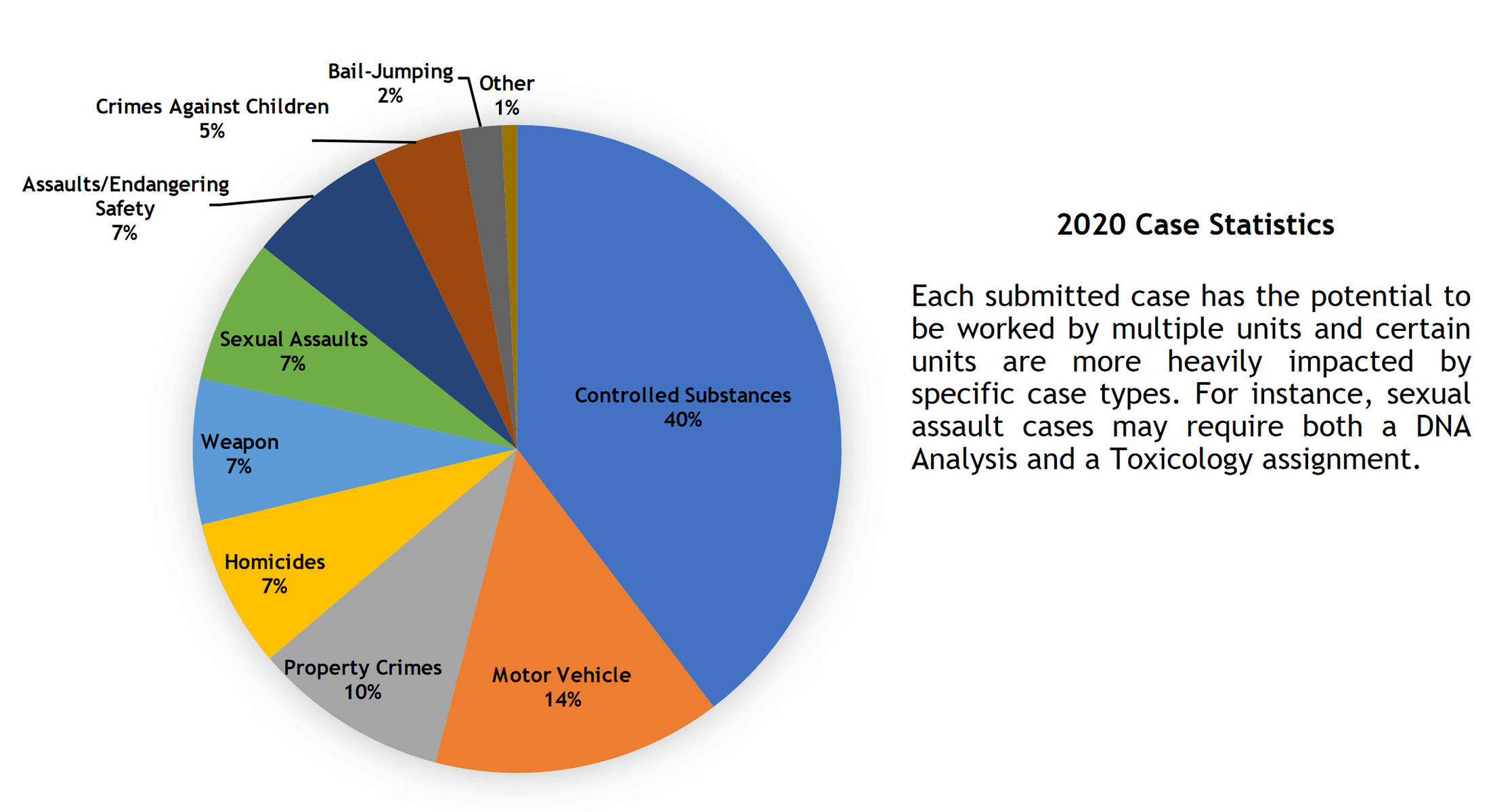
Budgets, of course, are about prioritization of resources, and Kaul is currently shelling out between $83,200 and $96,676 to hire an “Equity, Inclusion, and Wellness Program Director.” (He’s also seeking a DNA analyst. That person would earn up to $72,000.) He’s seen significant turnover of key staff, and he placed a controversial administrator over the Wisconsin crime labs for several months before reorganizing the hierarchy; she filed a federal complaint alleging ongoing harassment because she’s a black woman.
If prosecutors and police can’t get evidence they need processed, criminal cases can languish, keeping repeat offenders on the street and leaving victims without justice. In fact, the delayed processing of a DNA sample in a rape case helped end the tenure of Kaul’s mother, the late AG Peg Lautenschlager, when it turned out that the suspect was involved in the murder of a respected state drug agent in the interim. Thus, the backlogs in the crime lab – and the manner in which they can impact public safety – are no secret.
Two Republicans – Fond du Lac County District Attorney Eric Toney and UW-Madison Political Science Professor Ryan Owens – are currently locked in a primary for the chance to meet Kaul in a general election.
The Wisconsin Crime Lab Tale of the Tape Under Josh Kaul
DNA analysis: FAILURE. Delays are up when compared to Schimel, but the number of cases being accepted is down more than 50%, a trend that started before COVID.
DNA databank: FAILURE. Delays are up over Schimel, and cases are down across the board, including CODIS uploads.
Controlled substances: FAILURE. Delays are up slightly when compared to Schimel, even though the number of cases taken in and completed plummeted under Josh Kaul, a trend that started before COVID.
Toxicology (analyzing bodily fluids or tissue for alcohol and controlled substances): FAILURE. Delays are up when compared to Schimel. Josh Kaul had to outsource some of the cases to another agency.
Firearms: FAILURE in 2020, MIXED in 2019
Kaul’s record on firearms has gotten worse. He’s taken in slightly more cases but completed slightly fewer in 2020. However, his average and median turnaround times in 2020 are worse than Schimel’s. His record was better in 2019 in this area in case output and median turnaround time, but average was still worse than Schimel’s.
Toolmarks (analyzing marks on weapons at crime scenes): FAILURE. Although Schimel is listed as completing 0 toolmarks, and Kaul’s office has completed some, it’s operating with THREE-YEAR delays, so there’s no way we can label that a success.
Crime scene response: FAILURE. Delays are up, and the office responded to fewer crime scenes, a trend that started before COVID.
Latent prints: MIXED. Turnaround time improvements occurred, but his unit took in 28% fewer cases than Schimel, a trend that started before COVID.
Forensic imaging: MIXED. Average turnaround time dropped under Josh Kaul, but median turnaround time increased. One year, Kaul took in and completed fewer cases than Schimel, and the next he took in more. Work orders were down, a trend that started under COVID.
Trace evidence: SUCCESS. Josh Kaul’s turnaround time was better, and he took in slightly more cases, but output was 1 under Schimel.
Footwear: Mixed. Josh Kaul took in slightly more cases each year since taking office and improved the average turnaround time in this area.
To come up with our ratings, we looked at turnaround times but also considered whether output and intake had plummeted. It strikes us that if a crime lab is completing and/or taking in fewer cases in a time of rising crime, that’s also concerning and likely facts into turnaround times.
Changing Submission Guidelines & Rape Kits
Josh Kaul’s poor performance comes despite the fact the media unfairly hammered Schimel as supposedly “soft on crime” for backlogs that were far less severe than Kaul’s in many respects while Schimel’s Wisconsin crime lab handled more cases. The Democrat’s excuses are many, and they are excuses he certainly didn’t afford Schimel when he was campaigning for the job, using the issue as a cudgel.
The number of cases handled by the crime lab under Josh Kaul has dropped dramatically, by almost 30%, from 12,680 in Schimel’s last year in 2018 to 8,985 in 2020 under Kaul. Even before COVID, the number of cases Kaul’s DOJ is accepting for analysis decreased sharply. That’s according to Kaul’s own report.
The number of cases dropped 16% in 2019, the first year that Kaul was AG when compared to Schimel’s last year. The number of cases dropped by a smaller percentage, 15%, in 2020, the year COVID hit.
Check out what’s happened with the automated fingerprint identification system. Again, Schimel’s last year was in 2018, and Josh Kaul took office in 2019.
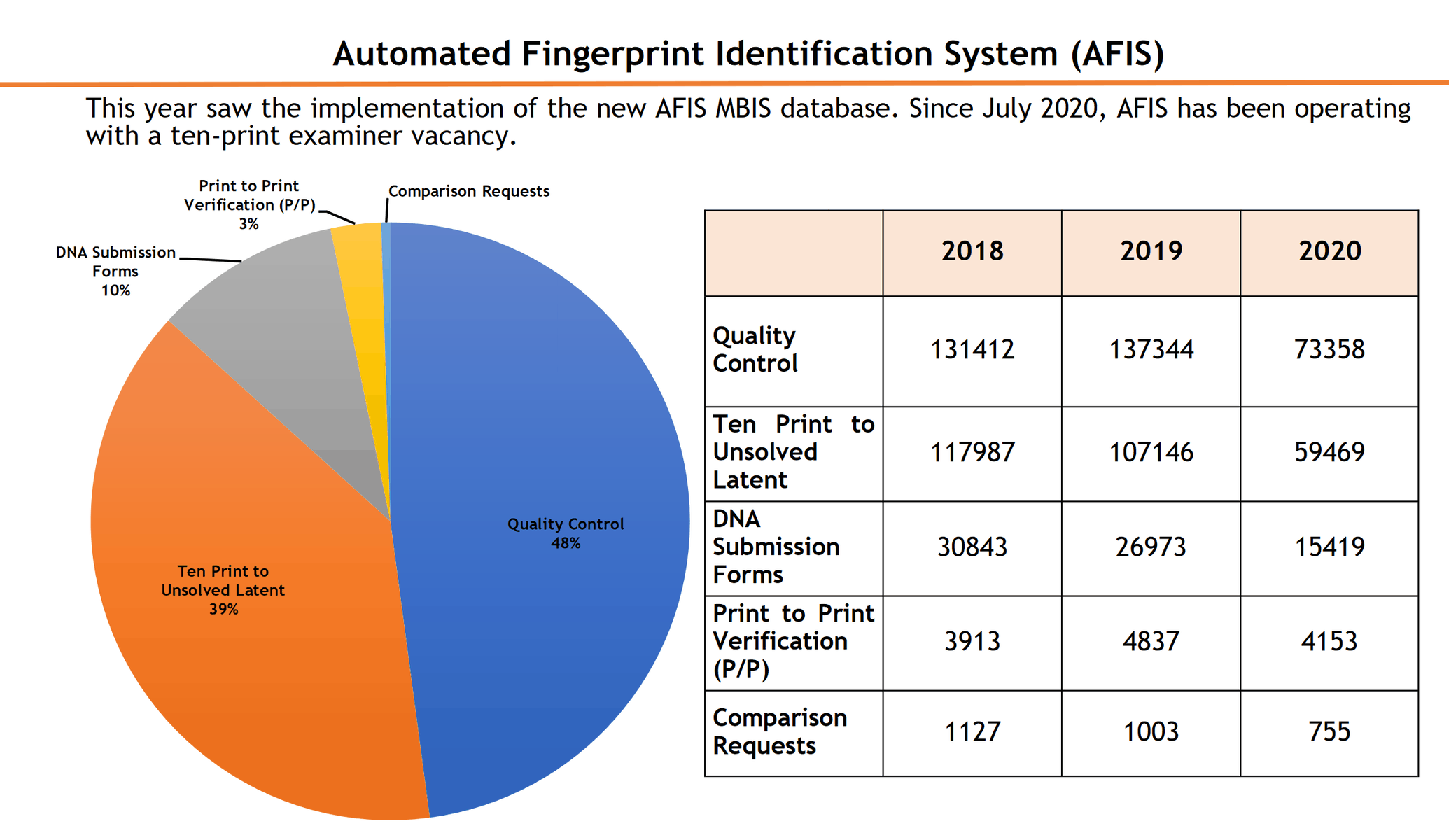
Kaul admits that his changes to submission guidelines played a key role in the number of cases dropping. His website lists statistics through his first year – 2019 – and says, “The decrease is likely caused by the completion of the Wisconsin Sexual Assault Case Initiative and the implementation of submission guidelines for many of the disciplines.” As noted, our comparisons also included 2020 numbers, which are available in a DOJ report. The Wisconsin Sexual Assault Case Initiative is the untested rape kit effort.
In 2019, Josh Kaul told Wisconsin Public Radio that one change in the submission guidelines involved the crime labs mostly testing felony controlled substance cases instead of misdemeanors. Indeed, Kaul’s own website shows that his agency has changed submission guidelines in all areas from 2019 through 2021.
The DNA unit is not accepting misdemeanor cases, fired cartridge cases, touch DNA evidence in some property crimes and collected in public places and cases with a jury trial date that is less than eight weeks from the date of submission to the laboratory. The crime lab also has a list of cases where it won’t accept firearms or toolmark evidence, including shootings without a named victim or suspect being charged and misdemeanor crimes.
A cynic might say changing submission guidelines might be an artificial way to drive down backlogs. If that was Kaul’s ploy, it backfired, because delays are up.
Josh Kaul has made a big deal of the rape kit testing issue as a partial driver of DNA caseload decreases during his tenure, although that doesn’t explain why it’s taking his analysts longer to turn around cases. Even Kaul has said the completion of the rape kit testing means analysts have more time for other things.
Overall, 4,471 kits were tested by November 2019, almost all in Schimel’s tenure. In September 2018, Schimel announced that “evidence related to 4,154 sexual assault cases have been tested” and only five cases still needed testing. Josh Kaul took office a few months later. Private labs received contracts to do the testing. The crime lab played a role in testing evidence from the private labs, according to the MacIver Institute. By May 2018, 1,884 of the rape kits had been tested.
Schimel was already working on the kit backlog for two years before Josh Kaul took office (rape kits were untested under previous AGs, including JB Van Hollen, Jim Doyle and Kaul’s mother, Lautenschlager; Schimel eliminated the backlog during his tenure yet he was still hit hard by Kaul, the media, and the Democrat Party as they turned it into a campaign issue.) The untested kits dated back to the 1980s. A DOJ report from 2018 found that clearing the untested rape kit backlog delayed testing in 350 other cases. Yet Schimel was pressured relentlessly by Kaul and the media to prioritize testing the old kits, even though they ultimately resulted in almost no findings of criminal guilt.
In a 2020 Wisconsin State Journal story on his 2019 DNA testing delay increases, Josh Kaul offered a litany of excuses, saying that he had to deal with 2018 cases that Schimel didn’t process because he was focused on untested rape kits (which Kaul made a huge campaign issue), and he said he wanted more analysts but Gov. Tony Evers and Republicans reduced his request.
More recently, Josh Kaul has switched to blaming the pandemic. Although that was obviously an aberrant situation, leadership means using ingenuity to not drop the ball on fighting crime at a time numbers were exploding. “To maintain adequate social distancing, DFS staggered work shifts in the laboratories and implemented procedures for non-lab work to be done remotely,” his report says. “New security protocols and systems were created to ensure data security during remote work.”
Although the pandemic is used frequently as an excuse, crime didn’t stop during it, and police and prosecutors didn’t get to sit it out. As a leader of a key crime fighting agency, it was incumbent on Kaul to show effective leadership.
Of the 2020 numbers, Kaul said, “The crime labs met the challenges of the pandemic and kept staff safe.” But did they keep the public safe? Kaul has also cited remote work as a factor affecting the crime lab backlogs.
It’s hardly like the crime lab backlog issue hasn’t been studied. Schimel commissioned a major report that offered a series of recommendations on improving the state crime lab.
Josh Kaul also claimed that a 2019 budget request for more firearm examiners was not approved. With campaign season starting to loom, Kaul and Gov. Tony Evers have demanded more money for the crime lab, including analysts. “The legislature made a significant investment in the crime labs in the last state budget. However, DOJ did
not receive everything requested, seeking 15 positions and receiving 7.4,” he wrote.
Kaul has also been battling Republicans to make it against state law for agencies to fail to submit more untested rape kits as the years pass – again, despite the lack of prosecutions that resulted from the first go around.
He also claimed drug analysts are overwhelmed with fentanyl cases. Kaul has sought more funding to prosecute those drug cases. He also blamed decreased spending flexibility, noting, “DOJ held position vacancies open in offices and divisions across DOJ longer than usual to help balance the budget, including vacancies in DFS.”
Quite honestly, at this point, it’s hard to think of an excuse Josh Kaul HASN’T made about the failures of the Wisconsin crime labs.
But the bottom line is that he has failed, and it’s imperiling public safety.
Here are the specific details about each crime lab area with charts from Josh Kaul’s most recent report:
DNA analysis – FAILURE
DNA analysis can make or break a criminal case. We ran across one case in Milwaukee where an illegal gun case was delayed for months because the prosecutor was waiting for DNA.
When people think of “crime lab backlogs,” they often think of DNA analysis.
But DNA analysis has become less effective under Kaul, even though the number of cases he’s taking in and completing have plummeted, again, which he blames on the rape kits in part.
For example, it took Josh Kaul’s crime lab an average of 97 days in 2019 and 94 days in 2020 to turn around a DNA case, compared to 80 days in 2018 under Schimel.
Yet Kaul’s office has had fewer cases to handle.
Schimel took in 8,626 DNA cases in 2018.
Even before COVID, Kaul’s crime lab was handling far fewer: 4,400 in 2019 and 3,820 in 2020.
That means the number of cases took in dropped 49% in Kaul’s first year, before COVID.
The office in 2020 handled a whopping 56% fewer DNA cases than Schimel’s last year.
Case output is a similar story.
It’s down 45% under Kaul.
So he’s doing worse with fewer cases. And that’s where the rubber meets the road.
Josh Kaul’s report explained, “The DNA Analysis unit worked in 2020 to get staff trained and competency tested in probabilistic genotyping, a new interpretation tool that assists the DNA Analyst in resolving previously uninterpretable profiles which can happen when a DNA sample is very small or includes a mixture of multiple individuals’ DNA. Even with the impact of COVID-19, the unit was able to successfully train a majority of the staff, perform casework in a remote environment, and evaluate new technologies to help increase efficiencies within the unit.”
DNA databank – FAILURE
What about the DNA databank? For example, DNA samples found in crime scenes are compared to the DNA databank for matches to people already in the system. Such CODIS comparisons are down 50% under Kaul, a trend that started before COVID.
These are important cases. Twenty-three percent are sexual assault cases. 10% are homicide or attempted homicide. 32% are burglary, 3% theft, 6% robbery and the rest are other.
Even Josh Kaul admitted this was a problem, but he blamed it on COVID. However, decreases in cases started before COVID.
For example, the sample intake numbers dropped each year under Kaul. CODIS uploads dropped each year under Kaul. Reported leads dropped each year. The average turnaround time was level from 2018 to 2019 and rose in 2020. The average turnaround time was level despite the drop in cases and then rose.
Josh Kaul’s report explained, with a slight discrepancy in numbers but the same trend lines, “The DNA Databank unit was heavily impacted by COVID-19. For the first time in two years, even though the receipt of reference DNA samples decreased, the number of samples in the queue greater than 30 days old increased from 0 to 250 and the turnaround time increased from 29 days to 39 days. Despite the challenges presented in 2020, the unit assisted law enforcement with 639 investigative leads (over 30% were to high priority crimes), five familial searches, including one success, and four repeat familial searches.”
Toxicology – FAILURE
Josh Kaul’s case output was less in 2019 and 2020 when compared to Schimel’s last year.
Kaul’s delays in processing toxicology cases rose in 2020 over Schimel’s last year. The average turnaround time was 39 days compared to 37 under Schimel.
Kaul ended up having to outsource some toxicology cases to another agency.
In the report, Kaul had a litany of excuses: “Toxicology continues to handle increased employee turnover and the training of new analysts. Challenges include keeping up with improvements and new methodology due to short staffing. Evolving case management strategies continues to improve efficiency. This relatively small unit was impacted by vacancies in the later part of 2020 and is now outsourcing cases to the State Laboratory of Hygiene to assist.”
Firearms – Failure in 2020, Mixed in 2019
Delays increased since Josh Kaul took office. It took more than 8 months to close a case on average. That’s much higher than it was during Schimel’s tenure.
For example, when it comes to firearms, it took Kaul’s Wisconsin crime lab 247 days on average to turn a case around in 2020. The trend existed before COVID. It took 258 days on average in 2019. Under Schimel’s last year? 209.
That means it’s taking, on average, more than a month longer for Kaul’s crime lab to process a firearms case than Schimel’s crime lab at a time that firearm violence is a growing concern.
The number of firearm cases handled was roughly consistent between the offices.
Kaul took in slightly fewer firearms cases than Schimel in 2019 (a 4% drop) and slightly more in 2020 (1 percent) when compared to Schimel’s last year.
However, Kaul’s output was worse in 2020 (403) than in Schimel’s last year (419). It rose in 2019 before dropping.
Josh Kaul’s excuse? “Firearms and Toolmarks Unit has been challenged by one unfilled vacancy. The unit was also challenged by the need to train several staff in toolmark analysis in the last two quarters of 2020, which was a success despite the challenges faced by COVID-19.”
Toolmarks – FAILURE
Delays rose significantly since Kaul took office. It took THREE YEARS to close a case on average. That’s much longer than under Schimel, but the numbers there are aberrant.
Under Kaul, it took an average 1,164 days to turnaround a toolmarks case in 2020, and 235 days in 2019. The number listed for Schimel, though, is 0 both in turnaround times and case output.
Kaul’s office handled slightly fewer toolmarks cases than Schimel (23 in 2020 compared to 25 in 2018, a 9% increase.)
What’s the excuse? As noted above in the firearms section, staffing.
Kaul also said toolmarks are usually involved in property crimes so they aren’t a priority, AP reported. With three-year delays, that’s for sure.
Controlled substances – FAILURE
Delays increased slightly in 2020 when compared to Schimel. It took almost a month and a half to close a case on average. However: This is despite the fact that Kaul’s Wisconsin crime lab is handling FAR fewer cases.
In Schimel’s last year, the average turnaround time was 43 days. Kaul’s Wisconsin crime lab dropped that his first year, again with plummeting caseloads, but it ticked back up to 44 days in 2020, higher than Schimel’s backlog.
But consider: In 2018, Schimel’s Wisconsin crime lab handled 5,283 controlled substance cases. Kaul’s crime lab handled far fewer, a trend that started before COVID- 4,861 in 2019 and 3,813 in 2020. That’s an 8 percent drop his first year and a 22% decrease in 2020. From Schimel’s last year through 2020, Kaul’s crime lab handled 28% fewer controlled substance cases – even as overdoses have exploded statewide.
That’s intake – cases brought in. Output – cases completed – was worse, a 32% drop in 2020 when compared to Schimel’s last year, a trend that started before COVID.
Kaul admitted there were problems in the report, which says, “Controlled Substances saw an increase in the number of illicit tablet cases and complexity of mixtures. The unit also continued to see new designer drugs and analogs. COVID-19 posed challenges in turnaround times and efficiency due to distancing requirements.”
Crime scene responses – FAILURE
Delays increased since Kaul took office, and the office responded to fewer crime scenes than when Kaul took office, a trend that started before COVID.
There was a 15% drop in crime scene responses in 2020 under Kaul when compared to Schimel’s last year.
Again, it’s not only COVID. In 2019, Kaul’s office did 13% fewer crime scene responses than Schimel’s.
The average turnaround times under Kaul have increased each year he’s been in office when compared to Schimel. The office had an average 49 days turnaround time in 2020.
His report explains, “The Crime Scene Response teams respond to many of the most complex crimes scenes in the state, providing a valuable service to law enforcement agencies of all sizes. The turnaround times in this unit refers to the finalizing of reports following the on-scene work.”
Under Kaul, this “valuable service” was less efficient, even though there were fewer crime scene responses. 38% of the cases were homicides.
Latent prints – MIXED
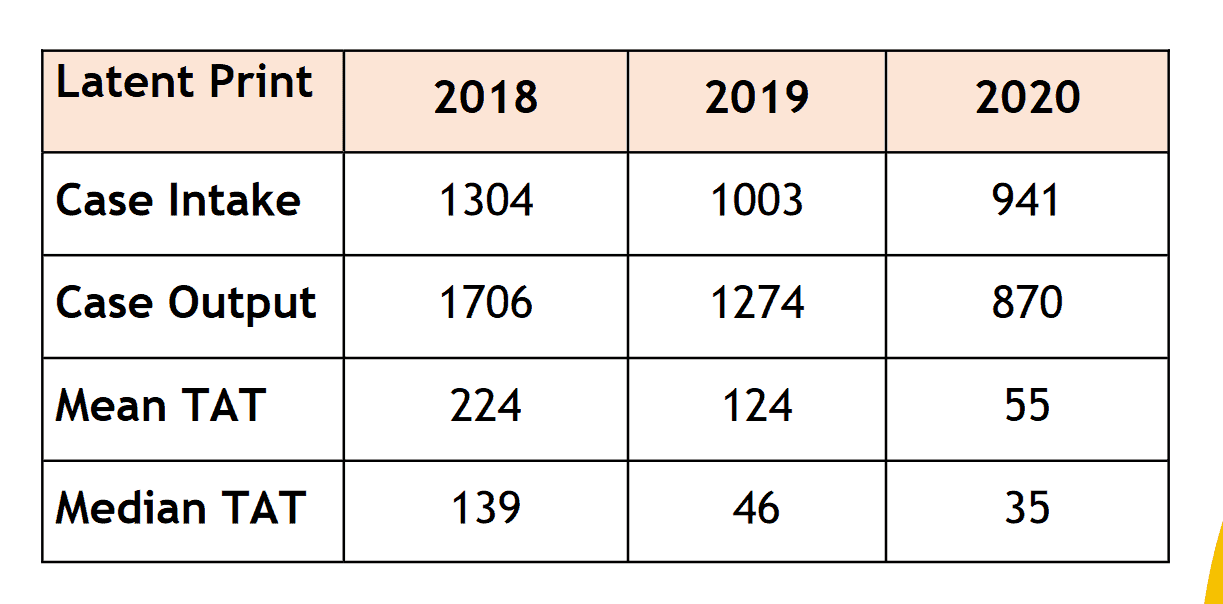
Case output has similarly dropped each year under Kaul – by 50% in 2020 when compared to Schimel’s last year. Once again this trend started before COVID – a 25% drop Kaul’s first year in office.
Kauls’ unit took in 28% fewer cases in 2020 when compared to Schimel’s last year, a trend that started before COVID (his first year, 2019, the office took in 23% fewer cases when compared to Schimel.)
Kaul’s average turnaround time for this kind of analysis improved, but it happened at a time that he took in fewer cases and completed fewer as well.
His average turnaround time was 55 days when compared to 224 under Schimel.
It’s hard to call this a success when he’s turning around cases faster because they’re finishing fewer of them. It’s not like crime is down.
Footwear – Mixed
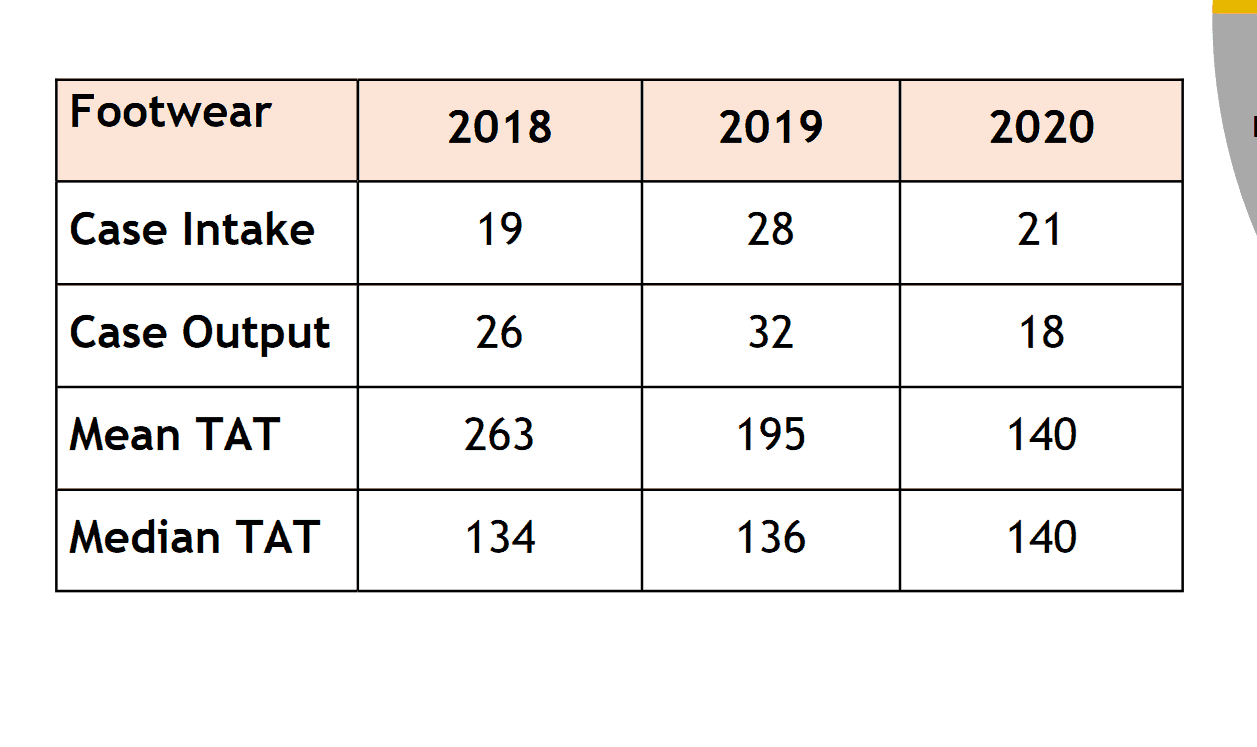
Kaul’s office had a dismal 30% case output decline in 2020 as compared to Schimel’s last year. His office improved the average turnaround time from 263 under Schimel to 140 in 2020, a positive trend that started before COVID.
The Latent Print and Footwear Unit moved to 100% verification of work which contributed to higher quality and an increased workload. The unit continues to train new staff and operate with unfilled vacancies,” Kaul claimed.
Trace evidence – SUCCESS
Kaul’s mean and median delays dropped when compared to Schimel’s last year, and he took in slightly more cases in 2020 than Schimel did in 2018 (145 compared to 126). However, in 2020, the unit’s case output dropped slightly from 133 when compared to 134 under Schimel.
Forensic imaging – MIXED
The average turnaround time dropped under Kaul from 62 in 2018 to 56 in 2020 (but it rose in 2019, his first full year in office). The median turnaround time has been higher each year he’s been in office when compared to Schimel. Both case intake and output declined under Kaul’s first year but are higher in 2020 than Schimel’s last year. Work orders are down, a trend that started before COVID.
Kaul’s report explained, “In addition to the work submitted to the Forensic Imaging Unit, the Imaging Specialists have been assigned the task of training Crime Scene Response (CSR) Photographers. This task has been challenging in the virtual work environment.
We requested an interview with AG Josh Kaul, he has not responded.


